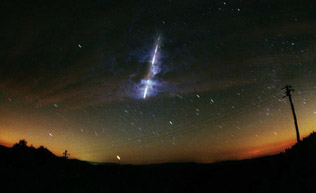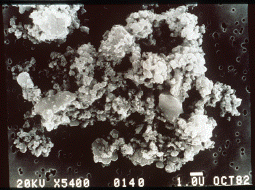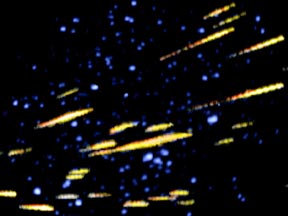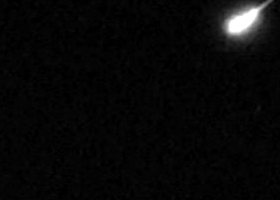Click on image for full size
Courtesy of Lorenzo Lovato of Imola, Italy
Meteors
Meteors are streaks of light, usually lasting just a few seconds, which people occasionally see in the night sky. They are sometimes called "shooting stars" or "falling stars", though they are not stars at all. Meteors are caused by the entry of small pieces of rock, dust, or metal from space into the atmosphere at extremely high speeds. These particles, called "meteoroids" when they are floating around in space (think of very small asteroids), are traveling at incredible speeds of tens of kilometers per second (tens of thousands of miles per hour) when they streak into the atmosphere. The incredible pressure meteoroids experience when they collide with Earth's atmosphere shatters them, transferring energy to atoms and molecules in the atmosphere, which then release the energy by glowing. This glow produces the bright trails of light in the sky we see as meteors.
Most meteoroid particles are quite small, ranging in size from a grain of sand to a pea-sized pebble. Almost all of them disintegrate in the atmosphere long before reaching the ground. Very rarely, a larger meteoroid actually survives to strike the ground, creating a meteor crater in a huge explosion. This explosion often vaporizes whatever solid material is left of the meteoroid after its fiery flight through the atmosphere. Sometimes, however, pieces of the meteoroid survive and are found in the crater or nearby. These chunks of rock or metal are called meteorites.
Meteors are not the same thing as comets. Meteors appear briefly as they streak through the sky. Comets are much larger objects that are actually still out in space. Comets can form tails, and though they do change position from night to night, they don't move fast enough for the eye to notice; they seem to hang in place in the sky. There is a connection, though, between some comets and some meteors. Several times each year Earth passes across the orbit of a comet, where dust and small bits of rock from the comet have been left behind. When this happens we can see many meteors in a single night; sometimes as many as 100 or more per hour! These events are called meteor showers.
Especially bright meteors are called fireballs. Some fireballs are so bright that they can be seen in the daytime. It would be possible to see meteors above any planet that has an atmosphere. A camera on the Mars Exploration Rover Spirit captured a picture of meteor in the sky above Mars in 2004!
How can you remember whether something is a meteor, a meteoroid, or a meteorite? Here's how I do it! When they are out in space, like asteroids, they are called meteoroids. When they are streaking through the atmosphere as bright flashes of light, we call them meteors - which reminds me of meteorology, which is the science concerned with weather and the atmosphere. [Meteorology is not the science of meteors!] When they reach the ground, we call them meteorites - which reminds me of the stalactites and stalagmites that are found under the ground in caves. I hope that helps you remember too!














